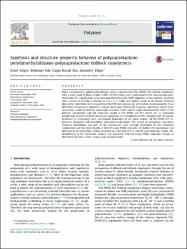| dc.contributor.author | Yılgör, Emel | |
| dc.contributor.author | Işık, Mehmet | |
| dc.contributor.author | Söz, Çağla | |
| dc.contributor.author | Yılgör, İskender | |
| dc.date.accessioned | 2021-03-30T07:00:39Z | |
| dc.date.available | 2021-03-30T07:00:39Z | |
| dc.date.issued | 2016 | en_US |
| dc.identifier.citation | Yılgör, E., Işık, M., Koşak Söz, Ç., & Yılgör, I. (2016). Synthesis and structure-property behavior of polycaprolactone-polydimethylsiloxane-polycaprolactone triblock copolymers. Polymer, 83, 138-153. | en_US |
| dc.identifier.uri | https://hdl.handle.net/20.500.12846/561 | |
| dc.description.abstract | Poly(ε-caprolactone)–polydimethylsiloxane–poly(ε-caprolactone) (PCL-PDMS-PCL) triblock copolymers with a wide range of block lengths (1000–32,000 g/mol) were synthesized by the ring-opening polymerization of ε-caprolactone using aminopropyl terminated PDMS oligomers as the initiator. Reactions were carried out in bulk or solution at 125 ± 5 °C under the catalytic action of tin octoate. Products obtained in high yields were characterized by FTIR spectroscopy, gel permeation chromatography, X-ray diffraction, temperature-dependent optical microscopy, differential scanning calorimetry, atomic force microscopy, scanning electron microscopy and static water contact angle measurements. Effect of the polymer composition and the molecular weight of the PDMS and PCL blocks on; (i) copolymer morphology and the extent of microphase separation, (ii) crystallization of PCL segments and (iii) surface properties of copolymers were investigated. Regardless of the block lengths, all PCL-PDMS-PCL copolymers displayed well microphase separated morphologies. The extent of microphase separation, resultant morphology and sizes of the microphases were strongly dependent on the copolymer composition and the block lengths of both PCL and PDMS segments. Crystalline PCL microphase was observed in all copolymers, which increased as a function of PCL content and molecular weight. Hydrophobicity of the copolymer surfaces was improved with increasing PDMS molecular weight, as determined by static water contact angle measurements. | en_US |
| dc.language.iso | eng | en_US |
| dc.publisher | Elsevier | en_US |
| dc.relation.isversionof | 10.1016/j.polymer.2015.12.024 | en_US |
| dc.rights | info:eu-repo/semantics/closedAccess | en_US |
| dc.subject | Triblock Copolymer | en_US |
| dc.subject | Polycaprolactone Copolymer | en_US |
| dc.subject | Polydimethylsiloxane Copolymer | en_US |
| dc.subject | Triblok Kopolimer | en_US |
| dc.subject | Polikaprolakton Kopolimer | en_US |
| dc.subject | Polidimetilsiloksan Kopolimer | en_US |
| dc.subject | Triblockcopolymer | en_US |
| dc.subject | Polycaprolacton Copolymer | en_US |
| dc.subject | Polydimethylsiloxan Copolymer | en_US |
| dc.title | Synthesis and structureproperty behavior of polycaprolactone-polydimethylsiloxane-polycaprolactone triblock copolymers | en_US |
| dc.type | article | en_US |
| dc.relation.journal | Polymer | en_US |
| dc.contributor.authorID | 0000-0003-3942-070X | en_US |
| dc.identifier.volume | 83 | en_US |
| dc.relation.publicationcategory | Makale - Uluslararası Hakemli Dergi - Kurum Öğretim Elemanı | en_US |
| dc.contributor.department | TAÜ, Fen Fakültesi, Malzeme Bilimi ve Teknolojileri Bölümü | en_US |
| dc.contributor.institutionauthor | Söz, Çağla | |
| dc.identifier.startpage | 138 | en_US |
| dc.identifier.endpage | 153 | en_US |

















